Bird beaks are available in a wide range of forms, sizes, and colors. And, contrary to popular belief, beak color serves as a social indication rather than a mating signal, as was previously thought.
Many birds encounter strong rivalry throughout mating and non-mating seasons. Colorful bills evolved as a means of displaying dominance and combat capacity toward others, allowing conflicts to be decided swiftly without having a physical confrontation.
Hence, what are different prominent orange-beaked birds?
When it refers to birds having orange-colored beaks, the number is lengthy. Northern cardinals, puffins, waxbills, well-known toco toucans, geese, certain hornbills, violet turacos, and several tern species (including the royal tern) are only a few examples.
Let’s dive right in and discover the various types of birds with orange beaks.
| Image | Name |
|---|---|
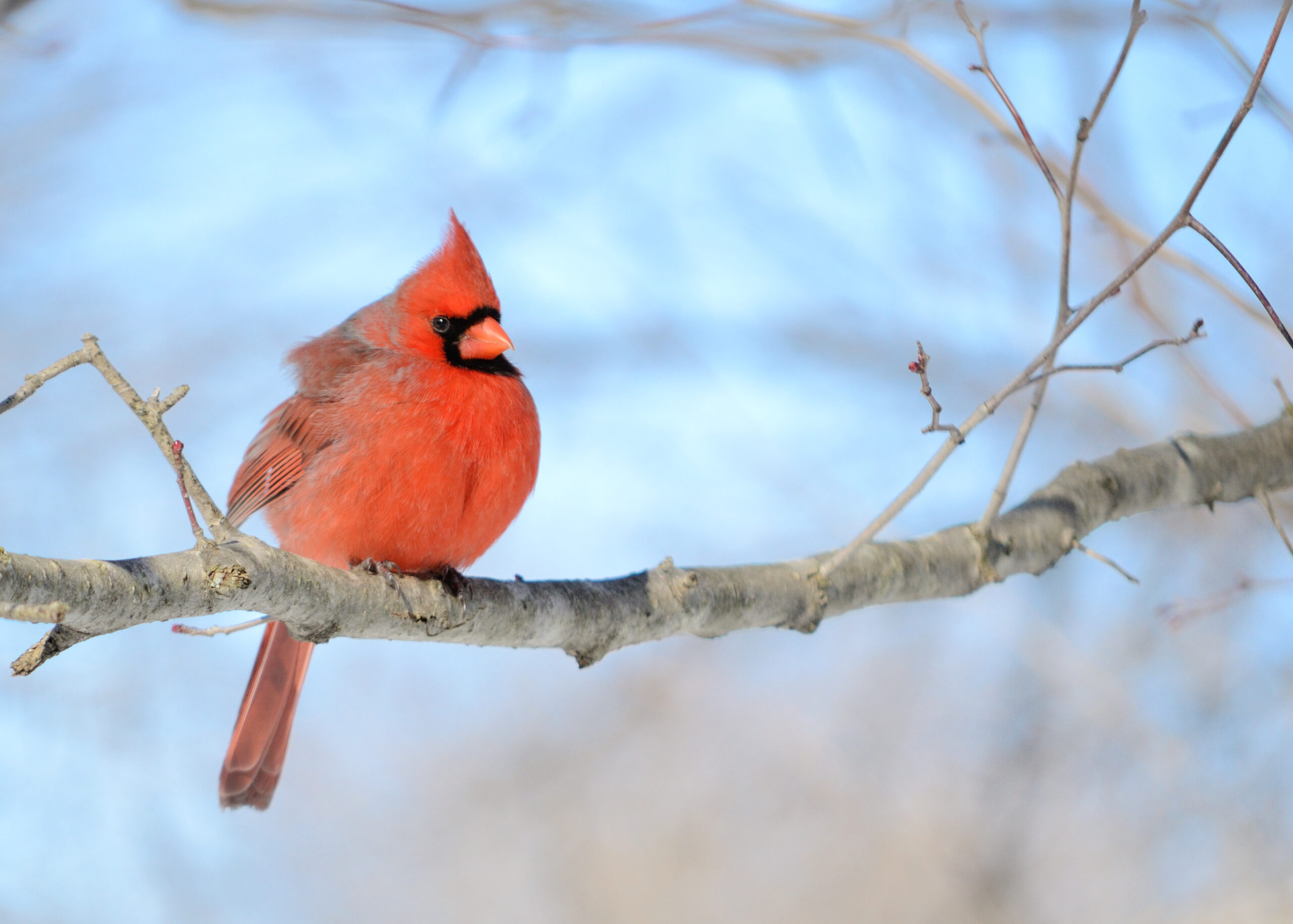 | Northern Cardinal |
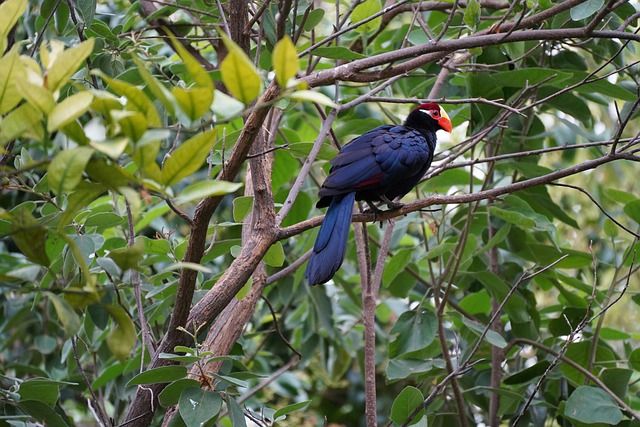 | Violet Turaco |
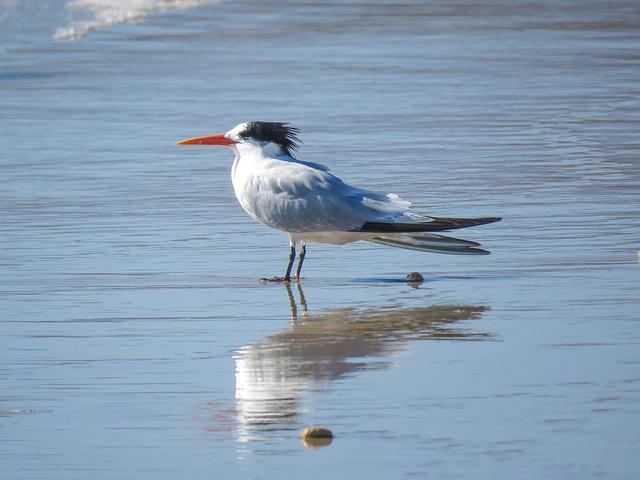 | Royal Tern |
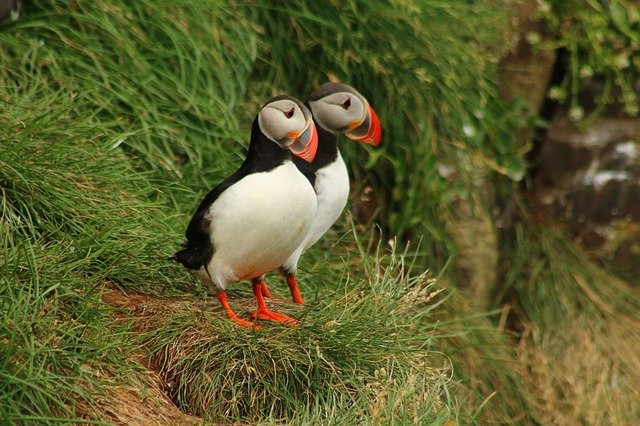 | Atlantic Puffin |
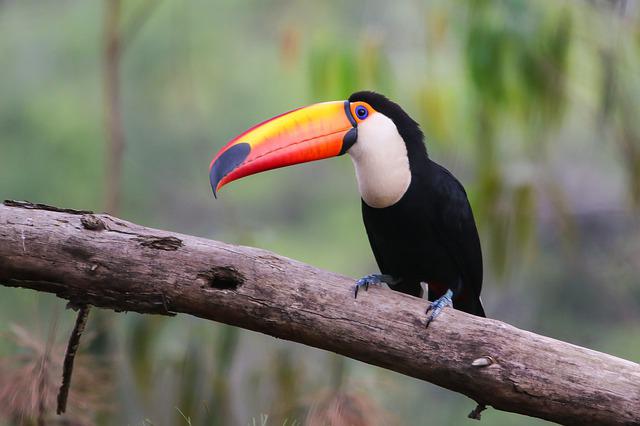 | Toco Toucan |
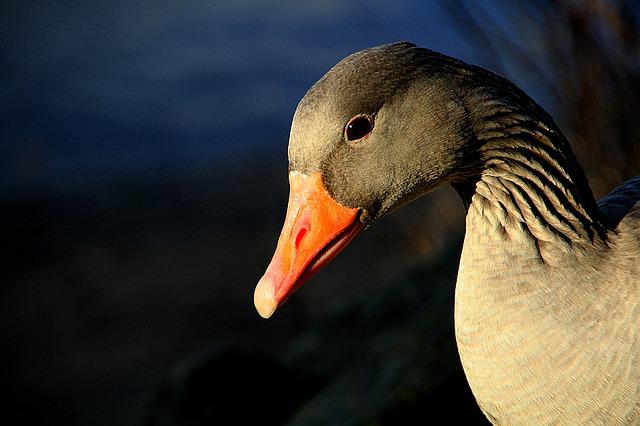 | Greylag Goose |
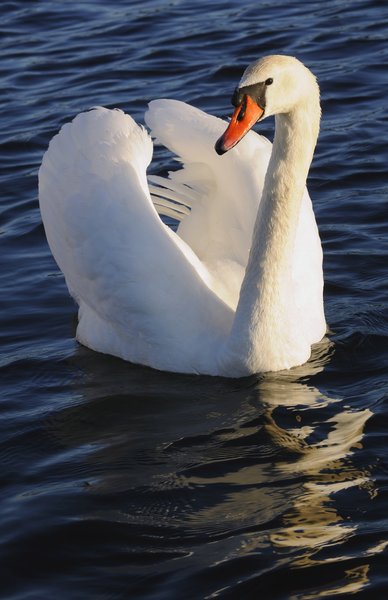 | Mute Swan |
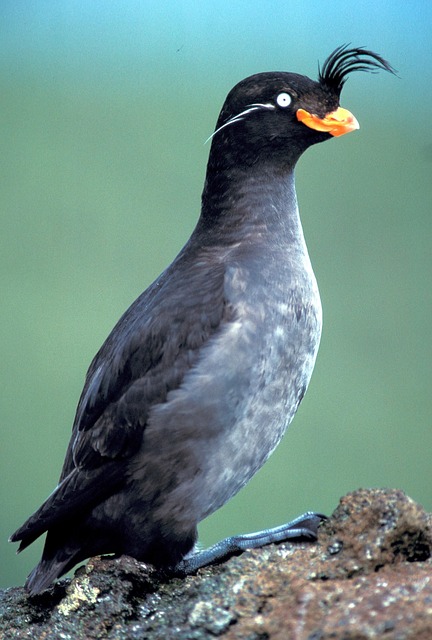 | Crested Auklet |
 | Rainbow Lorikeet |
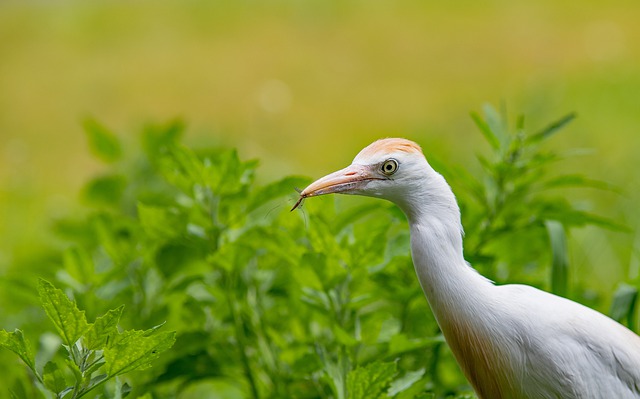 | Cattle Egret |
 | White-Throated Kingfisher |
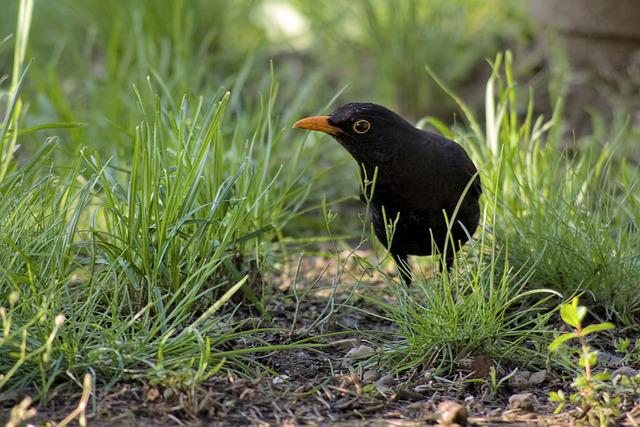 | Common Blackbird |
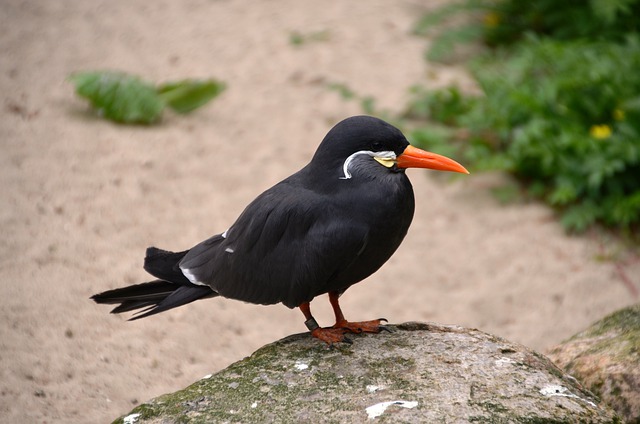 | Inca Tern |
 | Bank Myna |
 | Black-Breasted Thrush |
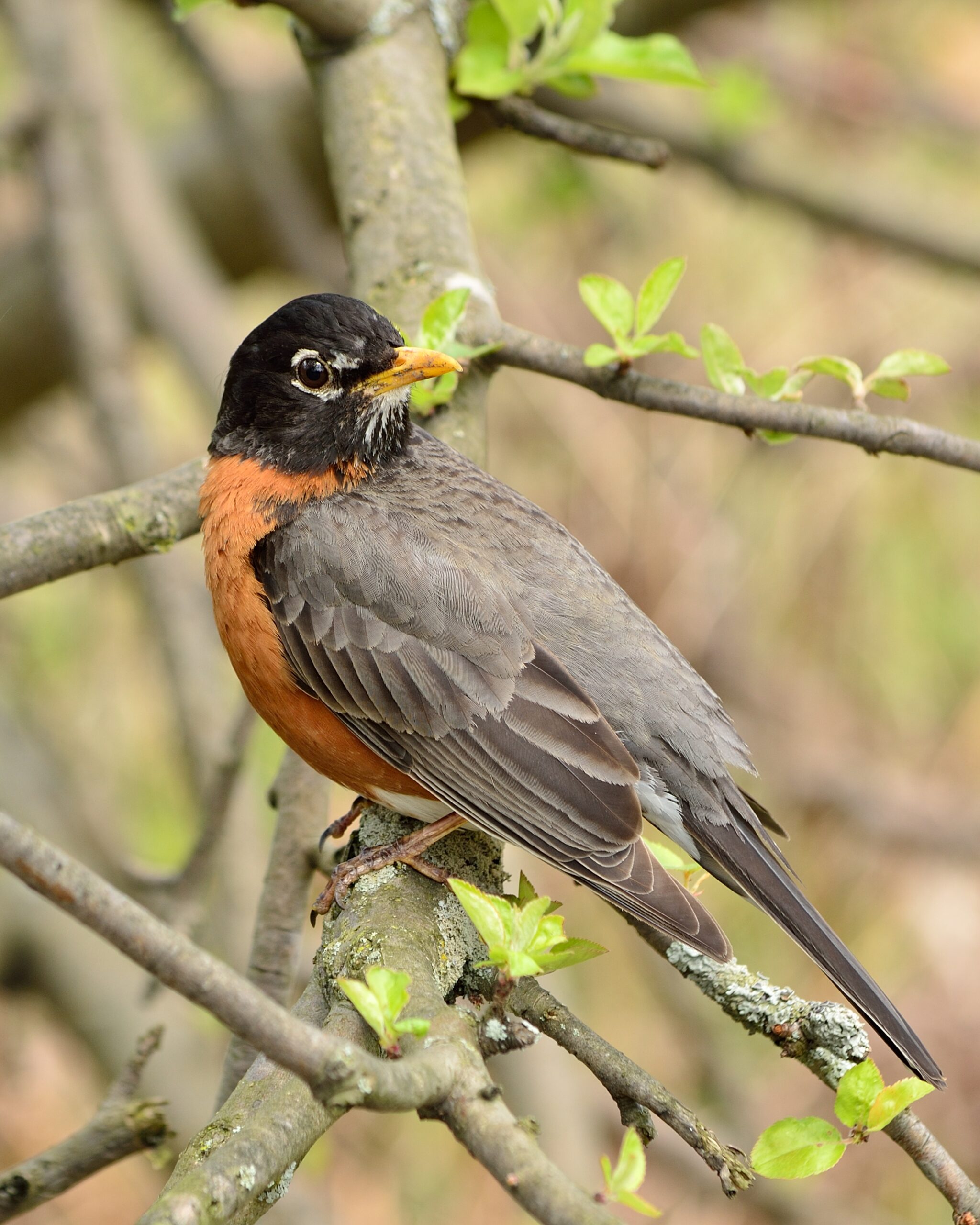 | American Robin |
Species of Birds With Orange Beaks
1. Northern Cardinal

Northern cardinals often referred to as redbirds, are medium-sized songbirds with a conspicuous crest and a short, extremely thick, and bright orange beak.
Male and female cardinals are easily distinguished because males are entirely red, having reddish beaks, whereas females are generally pale brown, having bright orange beaks.
The males and females both have feathered forehead crests.
Since they primarily eat on seeds, northern cardinals are classed as granivorous. Male cardinals get their red color via phytochemicals (carotenoids) in their meals.
They turn brownish if they don’t get enough of this pigment-triggering meal.
| Scientific name | Cardinalis cardinalis |
| Found In | Central America and the United States |
| Lifespan | 3 years |
| Beak Color | Orange-red |
| Wingspan | 10 to 12 inches |
Northern Cardinals pair for a lifetime and baldness in males is an indication that they’re in the process of a midsummer molt.
Northern cardinals live in eastern Mexico, Central America, and United States. It is the state bird of 7 states in the USA, including Virginia, Indiana, North Carolina, Ohio, Kentucky, Illinois, and West Virginia.
These are among the locations where you may discover it.
2. Violet Turaco

The violet turaco, commonly called the Violet Plantain-eater, is really a big bird with deep purple feathers. It gets its name “turaco” from its red wing and headbands, which are caused by a copper-based pigment known as “turacine.”
| Scientific name | Musophaga violacea |
| Found In | West Africa |
| Lifespan | up to 30 years |
| Beak Color | Bright orange |
| Wingspan | 8 to 9 inches |
Violet turacos are easily identified by their brilliant orange beaks, yellow foreheads, and redheads.
Violet turacos eat leaves, snails, flowers, seeds, buds, insects, fruits, and slugs. They are primarily found in tropical woods, forests, savannas, and marshes.
3. Royal Tern

The Royal tern is a huge seabird having gray-white feathers and short legs, an orange beak, as well as a black plume on its forehead. It may be found in temperate nearshore water areas in the Americas, Europe, and the Caribbean islands.
| Scientific name | Thalasseus maximus |
| Found In | South America, North America, West Africa |
| Lifespan | up to 30 years |
| Beak Color | Bright orange |
| Wingspan | 40 to 50 inches |
Carnivores and royal terns eat shrimp, tiny fish, and crustaceans. A flock of Royal Terns is referred to as a “highness.”
They may be seen in Florida in the United States. Carry your camera lens for bird photographing if you really want to snap good camera shots of terns.
4. Atlantic Puffin

The Atlantic puffin often referred to as the common puffin, is a small diving seabird with white breast and abdomen and black uppersides. It has white cheeks and face, orange webbed feet, and a yellow, black, and orange beak.
| Scientific name | Fratercula arctica |
| Found In | North Atlantic Ocean (Europe and North America) |
| Lifespan | 20 to 30 years |
| Beak Color | Multicolored (black, orange, yellow) |
| Wingspan | 19 to 25 inches |
The Atlantic puffin is a carnivorous bird that eats tiny fish such as hake, herring, sand eels, and capelin. Atlantic puffins are sometimes known as “sea parrots” due to their parrot-like beak.
They are outstanding fliers and relatively brief movers — puffins can flap their wings about 400 times a minute!
5. Toco Toucan

Toco toucan sometimes called a huge toucan, is the biggest and most well-known species of toucan. It is black in color with a white neck and orange skin around the eyes.
The beak of a Toco toucan is almost 7 inches in length and vivid orange in color.
| Scientific name | Ramphastos toco |
| Found In | South America |
| Lifespan | 20 years |
| Beak Color | Bright and dark orange |
| Wingspan | 40 to 60 inches |
Although it appears to be gigantic, the beak is really relatively light since it is hollow and formed of keratin. To maintain their beaks warm when sleeping, toucans tuck them under their wings.
They are still not particularly excellent fliers and prefer to hop between trees.
Toco toucans are omnivores that live in semi-arid areas of eastern and central South America.
6. Greylag Goose

The greylag goose has been the biggest wild goose species. It is indigenous to the British Isles and may be identified by its orange beak, white and grey feathers, and pink legs.
Its been domesticated since at least 1360 BC.
| Scientific name | Anser anser |
| Found In | Europe |
| Lifespan | 20 years |
| Beak Color | Orange to pink |
| Wingspan | 58 to 71 inches |
Greylag geese are generally diurnal creatures that are superb runners and swimmers. They can run and swim quickly and easily evade predators.
They are herbivores that eat berries, grain, water plants, leaves, and other plant material.
Greylag geese are monogamous, meaning they marry for a lifetime.
They may be spotted in gravel pits, parks, river valleys, and sometimes even tiny lakes and ponds.
7. Mute Swan

The mute swan is a big waterbird with all-white feathers and an orange beak with a black base. During the mating season, the black portion near the base of a male’s bill expands.
| Scientific name | Cygnus olor |
| Found In | North America |
| Lifespan | 15 to 20 years |
| Beak Color | Orange with a black base |
| Wingspan | 79 to 94 inches |
Mute swans are native to Europe and portions of Asia. However, they may also be spotted in the United States (particularly in Idaho, Oregon, California, and Arizona).
They are the national bird of Denmark.
Mute swans received their moniker since they are quieter than some other swan breeds. They are omnivores that eat aquatic vegetation, insects, seeds, and occasionally tiny fish.
8. Crested Auklet

| Scientific name | Aethia cristatella |
| Found In | the Bering Sea and Northern Pacific Ocean |
| Lifespan | 8 to 10 years |
| Beak Color | Bright orange |
| Wingspan | 13 to 20 inches |
The crested auklet has been a stocky, dark brown-black seabird having a feathered crown on top of the skull. It is a little bird having an orange beak that is short and thick. It is described as a grinning clown who never flickers and has a tangerine scent.
The Crested auklet is endemic to Japan, Russia, and North America. These birds are primarily planktivores, meaning they eat pteropods, copepods, krill, and other small animals.
9. Rainbow Lorikeet

The rainbow lorikeet is a little colorful parrot native to Australia. It features a vivid yellow-orange chest, a yellow-green collar, and a violet-blue neck. Adult lorikeets feature orange beaks, while young birds possess black beaks.
| Scientific name | Trichoglossus moluccanus |
| Found In | Australia |
| Lifespan | 20 years |
| Beak Color | Orange (adults) |
| Wingspan | 7 inches |
They have a population of approximately 5 million and are pleasant and clever birds. Rainbow lorikeets are omnivores who mostly consume blooms, fruits, pollen, berries, nectar, and buds.
They may consume insects on occasion. Rainbow lorikeets may be spotted in jungles, woodlands, and densely forested urban areas.
10. Cattle Egret

The cattle egret is a tiny heron having a broad neck and short legs, as well as dull orange legs and beaks. The cow egret takes its title from its propensity to chase after cattle and other big animals.
During the mating season, an adult’s white feathers turn golden on its chest, forehead, and upper back.
| Scientific name | Bubulcus ibis |
| Found In | North America, Africa, Europe |
| Wingspan | 3 feet |
| Beak Color | Bright orange |
| Lifespan | 16 to 23 years |
Many cattle egret species are very migratory and spend the winter season in Asia and North Africa. They eat lizards, frogs, worms, insects, and small animals on land.
11. White-Throated Kingfisher

The white-throated kingfisher has been a huge brown bird having vivid blue wings, back, and tail. It is also called the white-breasted kingfisher.
It has a big brown head and a big orange beak.
| Scientific name | Halcyon smyrnensis |
| Found In | Asia |
| Lifespan | 5 years |
| Beak Color | Heavy orange-red |
| Wingspan | 16 inches |
It may be spotted throughout Asia among agricultural areas, lakes, marshes, and clearings, from Sinai to the Indian subcontinent and the Philippines.
White-throated kingfishers are hostile toward both their own species and also other kingfisher families. They are carnivorous, eating crabs, fish, and prawns, as well as tiny snakes, tadpoles, insects, lizards, and earthworms.
12. Common Blackbird

The common blackbird is a somewhat wild bird that lives in forested areas, parks, gardens, and farmlands with hedges. Males possess completely black feathers and golden-orange beaks.
Females have reddish-brown chests and are brown.
| Scientific name | Turdus merula |
| Found In | Asia and Europe |
| Lifespan | 4 years |
| Beak Color | Brown (females), Orange (males) |
| Wingspan | 15 inches |
The common blackbird is omnivorous that eats seeds, worms, and fruits. Scientists believe there are between 160 and 500 million of these creatures on the planet.
13. Inca Tern

The Inca tern is often a large tern living in the primitive Inca Empire’s wetlands in South America. Its feathers are dark gray, with white mustaches on its face and bright orange legs and beak.
| Scientific name | Larosterna inca |
| Found In | Peru and Chile |
| Lifespan | 2 to 3 years |
| Beak Color | Bright red, orange |
| Wingspan | 12 inches |
The mustache is the tern’s care indicator; the longer it really is, the healthier the bird will be. Inca terns are piscivores that eat crab, shrimp, plankton, crayfish, fish, and other sea creatures.
Inca terns are kleptoparasitic, which means they take food from much other wildlife such as sea dolphins and lions.
Inca terns are also among the 25+ black-colored birds with white spots on their feathers in the list.
14. Bank Myna

The bank myna is one of the medium-sized birds native to northern South Asia. It is dark grey in color with dark wings and head and a bright orange bill and face.
| Scientific name | Acridotheres ginginianus |
| Found In | South Asia |
| Lifespan | 12 to 25 years |
| Beak Color | Vivid orange |
| Wingspan | 18 inches |
The bank myna was named after its lifestyle of nesting on river banks. It is an omnivore that eats seeds, food scraps, fruit, and animal food.
15. Black-breasted Thrush

The black-breasted thrush seems to be a vegetation bird native to northern Vietnam and India. Males and females share identical underpart colors; males are often black on the upper side, and females are usually gray-brown.
| Scientific name | Turdus dissimilis |
| Found In | Vietnam and India |
| Lifespan | 2 to 12 Years |
| Beak Color | Yellowish-orange |
| Wingspan | 22 – 23·5 cm |
These thrushes have orange-yellow feet, legs, and bills. They are omnivorous, eating mollusks, berries, and insects.
The black-breasted thrush’s song has already been explained as “sweet mellow” and “melodious,” with melodic phrases ranging from 3 to 8 notes.
16. American Robin

The American robin is one of the migrating songbirds that can be seen in gardens all over North America. It does have a gray head, gray wings, a red chest, and a gray back.
The small beak is a bright orange-yellowish color having a gray apex.
| Scientific name | Turdus migratorius |
| Found In | North America |
| Lifespan | 2 years |
| Beak Color | Bright orange-yellow |
| Wingspan | 12 to 16 inches |
Connecticut, Michigan, and Wisconsin all have state birds that are American robins. It enjoys sweet foods such as berries, fruits, and even pastries and cakes.
American robins are omnivorous, eating earthworms, insects, and caterpillars.
Conclusion
Many species of parrots, such as the rainbow lorikeet and red lory, raptors such as the bateleur, smaller birds such as the common blackbird, American robin, and other birds such as the mute swan, Inca tern, and Atlantic puffin have orange bills.
Most of these birds make excellent pets, and the tangerine beaks add to their general appearance.
Eventually, the next time you have any of these species in the forest, you will be able to identify them conveniently!
FAQ
What bird in New England does have an orange beak?
These birds sing all year. Adult male Northern Cardinals have the species’ signature red feathers, a black mask and an orange beak, and a ‘beard’ all around the face.
Last Updated on March 22, 2023 by Lily Aldrin

Another is the American Oyster Catcher